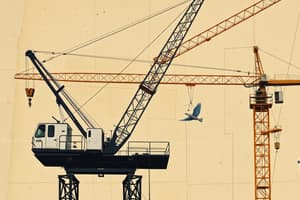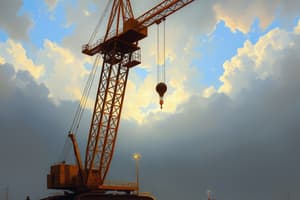Podcast
Questions and Answers
Which type of boom is characterized by being non-adjustable and commonly found in tower cranes?
Which type of boom is characterized by being non-adjustable and commonly found in tower cranes?
- Telescopic Boom
- Variable Boom
- Lattice Boom
- Fixed Boom (correct)
What is the primary function of counterweights in crane operation?
What is the primary function of counterweights in crane operation?
- To balance the crane and prevent tipping. (correct)
- To increase the lifting capacity of the crane.
- To control the speed of the boom
- To enhance the crane's maneuverability
What component provides the necessary lifting power for a crane?
What component provides the necessary lifting power for a crane?
- Slewing Gear
- Control Panel
- Turntable
- Winch (correct)
Which type of base is commonly found in tower cranes?
Which type of base is commonly found in tower cranes?
Which type of jib is designed to provide strength while reducing weight?
Which type of jib is designed to provide strength while reducing weight?
What is essential for the precise placement of loads using a crane?
What is essential for the precise placement of loads using a crane?
What feature distinguishes an overhead crane from other types?
What feature distinguishes an overhead crane from other types?
Which component of a crane is responsible for raising and lowering the load?
Which component of a crane is responsible for raising and lowering the load?
Which crane configuration allows for 360-degree horizontal movement?
Which crane configuration allows for 360-degree horizontal movement?
What powers the hydraulic systems used in cranes?
What powers the hydraulic systems used in cranes?
What feature distinguishes a telescopic boom from a fixed boom in crane design?
What feature distinguishes a telescopic boom from a fixed boom in crane design?
What type of crane typically utilizes overhead cranes for heavy lifting tasks?
What type of crane typically utilizes overhead cranes for heavy lifting tasks?
Which type of trolley moves along the lattice structure of a lattice boom crane?
Which type of trolley moves along the lattice structure of a lattice boom crane?
How does the ability to rotate and move a crane horizontally enhance its operation?
How does the ability to rotate and move a crane horizontally enhance its operation?
What is the primary function of outriggers on a crane?
What is the primary function of outriggers on a crane?
Which type of chassis allows for the movement of cranes?
Which type of chassis allows for the movement of cranes?
What is the primary power source for electric cranes?
What is the primary power source for electric cranes?
Which type of crane is characterized by a boom that extends and retracts like a telescope?
Which type of crane is characterized by a boom that extends and retracts like a telescope?
In which environments are diesel cranes typically found?
In which environments are diesel cranes typically found?
What distinguishes construction cranes from other crane types?
What distinguishes construction cranes from other crane types?
Which boom configuration provides strength and stability for heavy lifting?
Which boom configuration provides strength and stability for heavy lifting?
Which type of crane is most suitable for moving heavy equipment on uneven terrain?
Which type of crane is most suitable for moving heavy equipment on uneven terrain?
What is a common feature of hydraulic cranes?
What is a common feature of hydraulic cranes?
Which crane type would typically be used for high-rise construction projects?
Which crane type would typically be used for high-rise construction projects?
Flashcards are hidden until you start studying
Study Notes
Types of Cranes by Configuration
- All-Terrain Cranes: Suitable for various terrains, combining mobility and lifting capabilities.
- Truck-Mounted Cranes: Mounted on trucks for portability and quick setup.
- Crawler Cranes: Equipped with tracks for stability, ideal for rough terrains.
Boom Configuration Types
- Lattice Boom Cranes: Feature a lattice structure providing strength; commonly used in large construction sites, often seen as tower cranes.
- Telescopic Boom Cranes: Capable of extending and retracting their boom, allowing flexibility for various construction and maintenance tasks.
Power Source Classifications
- Electric Cranes: Operate on electricity, suited for indoor use in warehouses and factories.
- Hydraulic Cranes: Utilize hydraulic systems for lifting, known for robust power; frequently found in mobile and larger industrial cranes.
- Diesel Cranes: Powered by diesel engines, ideal for outdoor settings without steady power sources.
Crane Applications
- Construction Cranes: Specifically designed for construction tasks, including tower, mobile, and rough terrain cranes for lifting heavy materials and equipment.
Boom Mechanics
- Principle of Boom Operation: The boom can extend, retract, or angle, influencing reach and lifting capacity; crucial for optimizing safety and efficiency in operations.
Rotation and Movement
- Precision Mechanisms: Cranes have systems that allow for boom rotation and horizontal movement, essential for accurate load placement.
Key Crane Components
- Boom or Mast: The primary arm that supports loads; can be fixed or telescopic for variable reach.
- Jib: An extension of the boom for enhanced reach; can be horizontal or lattice design for strength.
- Counterweights: Used for stability, preventing tipping; includes fixed and adjustable types based on load requirements.
- Hoist Mechanism: Comprises winch and lifting ropes/chains for raising and lowering loads.
- Trolley: Moves along the boom for horizontal load positioning; types include bridge and lattice trolleys.
- Rotation Mechanism: Allows 360-degree movement; consists of slewing gear and turntable.
- Outriggers: Stabilizing supports that extend from the base to prevent tipping; available in manual and hydraulic types.
- Cab: Enclosed area for the operator, featuring a control panel for operations and designed for visibility.
- Base or Chassis: Provides support; can be fixed (for tower cranes) or mobile (for crane types like crawlers).
- Electrical and Hydraulic Systems: Power crane functions; include hydraulic pumps and electrical motors for movement and lifting.
Importance of Understanding Crane Components
- Recognizing the roles of various components aids in selecting the right crane for tasks, ensuring safe and efficient operation, and facilitating effective maintenance.
Studying That Suits You
Use AI to generate personalized quizzes and flashcards to suit your learning preferences.




